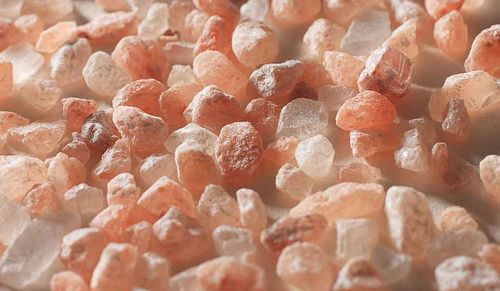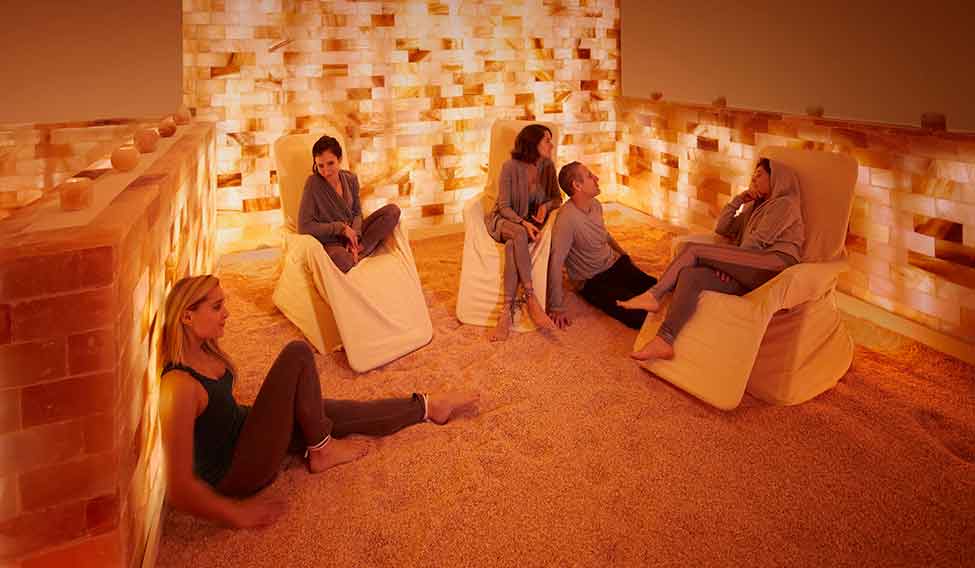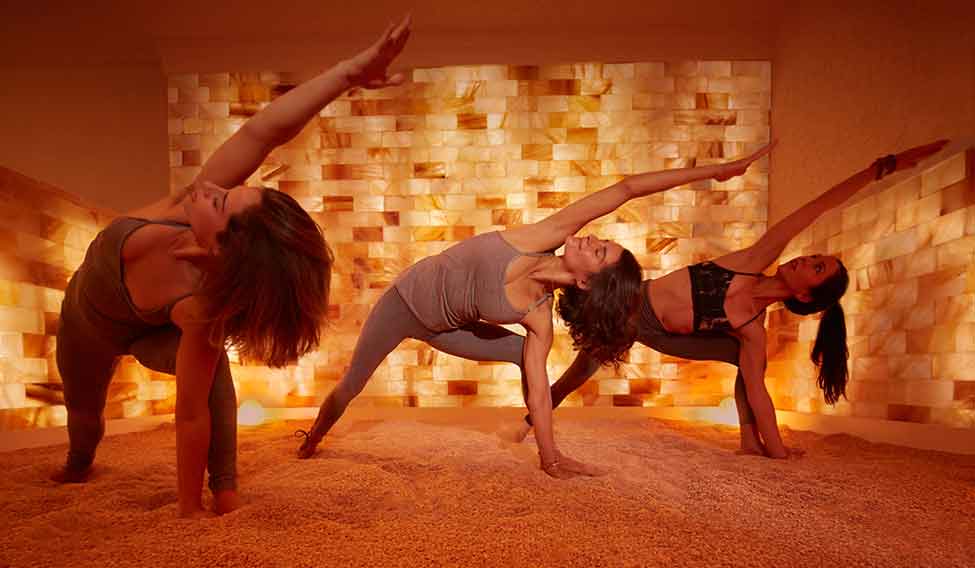In New York, where working out is practically a religion, people are always on the lookout for the next big thing. Usually it is a killer exercise class, where people push themselves to their limits and stagger out sweaty and exhausted, that generates the biggest buzz among the city’s Type As. The latest fitness phenomenon to grab everyone’s attention is, however, something altogether more gentle—salty yoga.
Yes, you read that correctly. Founder Ellen Patrick is accustomed to people thinking that salty yoga is a gimmick. “Most people don’t know how to breathe efficiently, because of postural dysfunction, so we’re combining the strength, flexibility and increased range of motion that you get through yoga with the healing and therapeutic qualities of salt,” she says.
Salt therapy, also known as halotherapy, has been used for centuries to improve health and overall wellness. It is believed to be particularly effective in alleviating respiratory problems such as asthma and bronchitis by reducing inflammation in the sinuses and clearing airways. This effect was first discovered in 1843, when a Polish doctor called Feliks Boczkowski noted that workers in a salt mine had excellent respiratory health. After this, salt spas proliferated throughout eastern Europe and the rest of the world soon caught on. Man-made salt rooms are increasingly common in cities like London and New York, and are used for relaxation purposes and general wellness in spas, and to help people with breathing problems in clinics. (Therapeutic sessions at the UK’s biggest chain of salt rooms, The Salt Cave, start at £35.)
 Breathesaltrooms.Com
Breathesaltrooms.Com
Dry-salt therapy is said to strengthen the immune system, improve skin conditions such as eczema and psoriasis, soothe allergies and help combat respiratory ailments including the common cold—though the evidence for this is mostly anecdotal. The negative ions given off by salt are also said to combat the positive ions emitted by computers, TVs and mobile phones.
Patrick, a yoga teacher for 16 years, is a convert. “Salt is a natural and effective antibacterial, antiviral, anti-fungal and anti-inflammatory mineral,” she says. She and her husband own a small chain of salt rooms called Breathesaltrooms and have a salt cabin installed in their home. “I go in there with my little dog in my arms and we both breathe better afterwards,” she says. As an experiment, Patrick put yoga and halotherapy together and multitasking New Yorkers queued up to try it. After all, why do one therapeutic practice when you can do two at the same time?
The salt room in downtown Manhattan where Patrick’s salty yoga classes take place is certainly soothing and pretty. The walls are covered in pink Himalayan salt bricks, lit from behind, and salt crystals cover the floor to a depth of six inches. Crunching over them in bare feet, it feels like being on a beach. Patrick says that millions of microscopic particles of salt are also being pumped into the room using a machine called a halogenerator.
I join in with a class, where we are taken through a series of yoga poses, including cobra and upward dog, to help stretch and open the chest and shoulders. “Salty yoga helps to strengthen and stretch the primary muscles of respiration, increasing breath capacity, oxygenation and endurance,” says Patrick. “At the same time, dry-salt therapy helps to clear your air passages, giving increased lung capacity and function.”
We breathe without thinking about it, of course, but people who practise deep breathing claim they experience profound improvements in their overall health, such as lowered blood pressure and heart rate and an improved feeling of wellbeing. Research has shown that controlled breathing helps some people to cope with chronic pain.
In frenetic New York, breathing trainers teach people how to combat stress and how to re-energise using the breath. Amateur athletes use fitness devices such as Expand-A-Lung that claim to improve the strength of respiratory muscles and increase the volume of oxygen intake.
Al Lee is the co-author of Perfect Breathing and his seminars attract crowds all over the US. He also works with corporations, training staff how to improve their performance and how to handle stress through conscious breathing.
“If you’ve ever watched a baby breathe, you may have noticed that their belly rises and falls as they breathe, like a balloon filling and deflating as they inhale and exhale,” he says. “In contrast, most adults take small sips of air into their upper chest and shoulders. This is due to a number of factors. First, I’ve yet to meet someone who is trying to get their stomach to stick out more. Everyone wants that flat six-pack stomach, and consequently we tend to hold our stomachs in. Combine that with hours and hours of sitting—behind a desk, behind the steering wheel and in front of the television.
“All that sitting restricts the abdomen, and over the years the breath takes the path of least resistance and moves higher and higher up in the chest, until eventually we become accustomed to talking short, shallow, subsistence breaths into the top of our lungs. That short, shallow breath causes a cascade of negative effects that affect your mind, emotions, health and performance, including higher blood pressure, a suppressed immune system and negative emotions.”
 Chillax: People relax between yoga salt therapy sessions | Breathesaltrooms.com
Chillax: People relax between yoga salt therapy sessions | Breathesaltrooms.com
Normally, Lee adds, we breathe 15 to 20 times per minute, depending on the constantly shifting tides of our emotions. “Recent medical research has shown that when your breathing slows down to approximately 10 breaths per minute, there is a corresponding cascade of positive effects to your mind, body, emotions and physical performance,” he continues. “Your blood pressure comes down, your heart rate slows, healing is accelerated and your immune system ramps up—making you more resistant to colds, flu and other threats to your health. Slower, deeper breathing also opens the door to potentially dramatic improvements in physical and athletic performance.”
Yoga and breathing go hand in hand, of course. Practitioners have used pranayama—the control and extension of the breath, or life-force energy—for thousands of years. For the average yoga student, this is easier said than done, says Patrick. “They’re so focused on where to raise their right arm or their left arm, or bending a knee or curling their toes, that breathing falls by the wayside,” she says.
This rings a bell. As a yoga beginner, there are many times when, trying to hold warrior II or maintain a plank, I scarcely breathe at all, while others around me seem peaceful and contemplative. The nearest I have come to ujjayi breathing—where the breath sounds like the waves of the sea—is a strangled gargle.
With salt being pumped into the room, however, I seem to be breathing more deeply and easily. Patrick says this is because the salt that is being aerated into the atmosphere is opening the body’s airways and relieving congestion. Then again, salty yoga is a slow and gentle workout, and it’s hard not to feel relaxed in the darkened room. My clothes are covered in salt dust and I can taste salt on my lips. We discard our yoga mats and do downward dogs directly on the salt surface, digging our toes and heels into the salty granules. “You’re getting a free pedicure at the same time,” jokes Patrick.
Most of us breathe in far less than our natural lung capacity allows, Patrick reminds the class: “We go days without using our diaphragms, relying on the weaker intercostal muscles between the ribs. When your body gets those extra particles of oxygen, your mental focus improves, you feel more serene and the tightness in your shoulders and back eases.”
In the days after the salty yoga class, I realise I am one of those shallow breathers that Lee talked about and, though it does not come naturally, I’m trying to think more consciously about how I inhale and exhale. I have a renewed appreciation of that old piece of advice—take a deep breath and relax.







